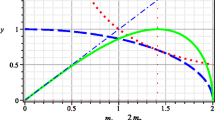Abstract
In this paper, two independent methods are used to show that the non-Hermitian \(\mathcal{P}\mathcal{T}\)-symmetric wrong-sign quartic Hamiltonian H = (1/2m)p 2 − gx 4 is exactly equivalent to the conventional Hermitian Hamiltonian \(\tilde H = ({1 \mathord{\left/ {\vphantom {1 {2m}}} \right. \kern-\nulldelimiterspace} {2m}})p^2 + 4gx^4 - \hbar ({{2g} \mathord{\left/ {\vphantom {{2g} m}} \right. \kern-\nulldelimiterspace} m})^{{1 \mathord{\left/ {\vphantom {1 2}} \right. \kern-\nulldelimiterspace} 2}} x\). First, this equivalence is demonstrated by using elementary differential-equation techniques and second, it is demonstrated by using functional-integration methods. As the linear term in the Hermitian Hamiltonian \(\tilde H\) is proportional to ℏ, this term is anomalous; that is, the linear term in the potential has no classical analog. The anomaly is a consequence of the broken parity symmetry of the original non-Hermitian \(\mathcal{P}\mathcal{T}\)-symmetric Hamiltonian. The anomaly term in \(\tilde H\) remains unchanged if an x 2 term is introduced into H. When such a quadratic term is present in H, this Hamiltonian possesses bound states. The corresponding bound states in \(\tilde H\) are a direct physical measure of the anomaly. If there were no anomaly term, there would be no bound states.
Similar content being viewed by others
References
V. Buslaev and V. Grecchi: J. Phys. A: Math. Gen. 26 (1993) 5541.
H.F. Jones and J. Mateo: Phys. Rev. D 73 (2006) 085002, arXiv:quant-ph/0601188.
C.M. Bender, D.C. Brody, J.-H. Chen, H.F. Jones, K.A. Milton, and M.C. Ogilvie: Phys. Rev. D 74 (2006) 025016, arXiv:hep-th/0605066.
C.M. Bender and S. Boettcher: Phys. Rev. Lett. 80 (1998) 5243.
C.M. Bender, S. Boettcher, and P.N. Meisinger: J. Math. Phys. 40 (1999) 2201.
C.M. Bender, F. Cooper, P.N. Meisinger, and V.M. Savage: Phys. Lett. A 259 (1999) 224.
P. Dorey, C. Dunning, and R. Tateo: J. Phys. A: Math. Gen. 34 (2001) L391; 5679.
See, for example: G. Lévai and M. Znojil: J. Phys. A 33 (2000) 7165. C.M. Bender, G.V. Dunne, P.N. Meisinger, and M. Simsek: Phys. Lett. A 281 (2001) 311. B. Bagchi and C. Quesne: Phys. Lett. A 300 (2002) 18. D.T. Trinh: PhD Thesis, University of Nice-Sophia Antipolis, 2002. For further references see Proceedings of the First, Second, Third, and Fourth International Workshops on Pseudo-Hermitian Hamiltonians in Quantum Mechanics in Czech. J. Phys. 54 (2004) issues #1 and #10, 55 (2005) issue #9, and in J. Phys. A: Math. Gen. 39 (2006) (to appear); see also T. Tanaka: arXiv:hep-th/0605035 and arXiv:hep-th/0603096.
K. Symanzik: Commun. Math. Phys. 45 (1975) 79.
C.M. Bender, K.A. Milton, and V.M. Savage: Phys. Rev. D 62 (2000) 85001.
F. Kleefeld: J. Phys. A 39 L9 (2006), arXiv:hep-th/0506142; arXiv:hep-th/0408097.
C.M. Bender, P.N. Meisinger, and H. Yang: Phys. Rev. D 63 (2001) 45001.
Z. Ahmed, C.M. Bender, and M.V. Berry: J. Phys. A: Math. Gen. 38 (2005) L627.
C.M. Bender, D.C. Brody, and H.F. Jones: Phys. Rev. Lett. 89 (2002) 270401; Am. J. Phys. 71 (2003) 1095.
A. Mostafazadeh: J. Math. Phys. 43 (2002) 205; J. Phys. A: Math. Gen. 36 (2003) 7081.
C.M. Bender, D.C. Brody, and H.F. Jones: Phys. Rev. Lett. 93 (2004) 251601; Phys. Rev. D 70 (2004) 025001. C.M. Bender, I. Cavero-Pelaez, K.A. Milton, and K.V. Shajesh: Phys. Lett. B 613 (2005) 97, arXiv: hep-th/0501180. C.M. Bender and B. Tan: J. Phys. A: Math. Gen. 39 (2006) 1945, quant-ph/0601123. C.M. Bender, H.F. Jones, and R.J. Rivers: Phys. Lett. B 625 (2005) 333, arXiv:hep-th/0508105. C.M. Bender, P.N. Meisinger, and Q. Wang: J. Phys. A: Math. Gen. 36 (2003) 1973. C.M. Bender, J. Brod, A. Refig, and M.E. Reuter: J. Phys. A: Math. Gen. 37 (2004) 10139.
C.M. Bender, S. Boettcher, H.F. Jones, P.N. Meisinger, and M. Simsek: Phys. Lett. A 291 (2001) 197.
Author information
Authors and Affiliations
Rights and permissions
About this article
Cite this article
Bender, C.M. Parity anomaly in a \(\mathcal{P}\mathcal{T}\)-symmetric quartic Hamiltonian. Czech J Phys 56, 1047–1062 (2006). https://doi.org/10.1007/s10582-006-0399-5
Received:
Issue Date:
DOI: https://doi.org/10.1007/s10582-006-0399-5



